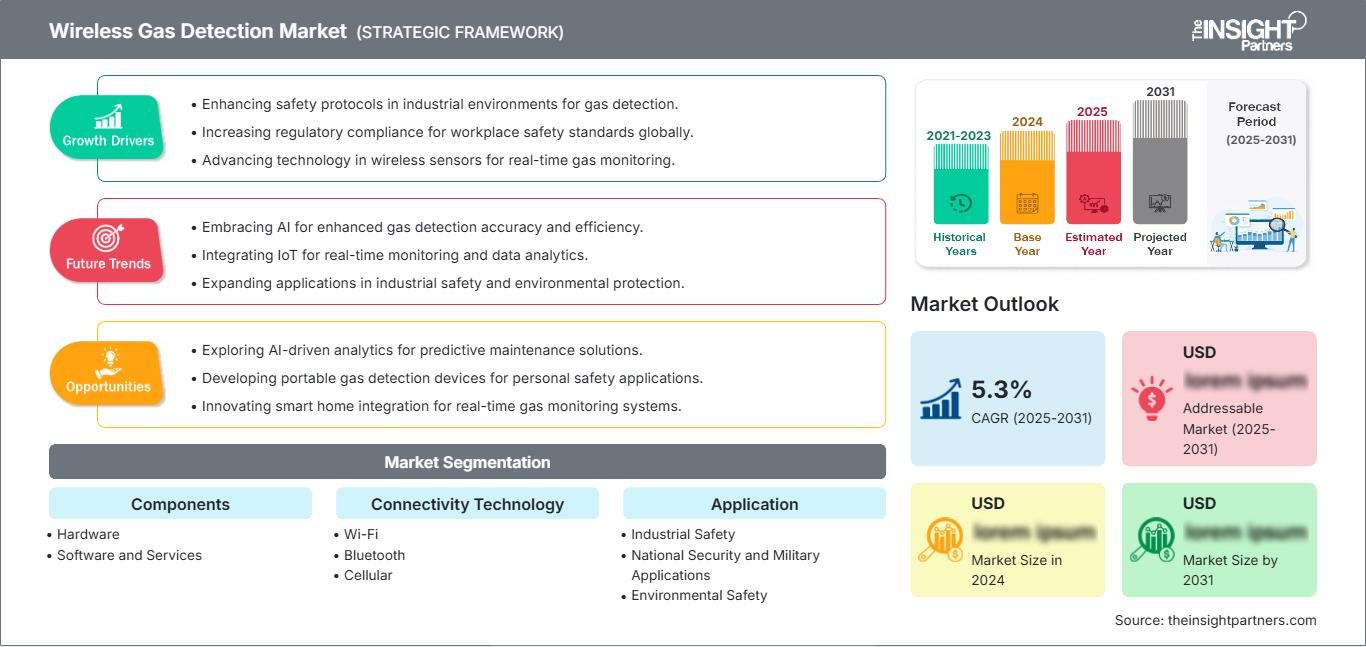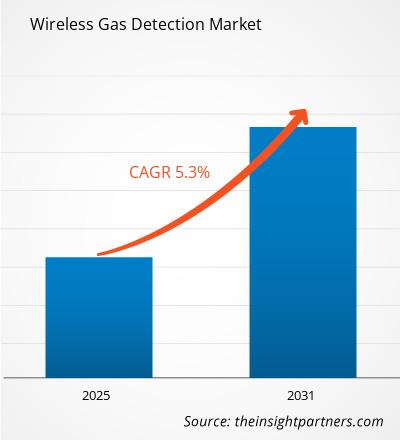Si prevede che il mercato del rilevamento di gas wireless registrerà un CAGR del 5,3% dal 2025 al 2031, con una dimensione del mercato in espansione da XX milioni di dollari nel 2024 a XX milioni di dollari entro il 2031.
Il rapporto è segmentato per componenti (hardware, software e servizi), tecnologia di connettività (Wi-Fi, Bluetooth, cellulare e banda ISM senza licenza), applicazione (sicurezza industriale, sicurezza nazionale e applicazioni militari e sicurezza ambientale), utente finale (petrolio e gas, prodotti chimici e petrolchimici, energia e servizi di pubblica utilità, estrazione mineraria e metalli, governo e forze armate). L'analisi globale è ulteriormente suddivisa a livello regionale e per i principali paesi. Il rapporto offre il valore in dollari per l'analisi e i segmenti sopra indicati.
Scopo del rapporto
Il rapporto sul mercato del rilevamento di gas wireless di The Insight Partners mira a descrivere il panorama attuale e la crescita futura, i principali fattori trainanti, le sfide e le opportunità. Ciò fornirà spunti a vari stakeholder aziendali, come:
- Fornitori/produttori di tecnologia: per comprendere le dinamiche di mercato in evoluzione e conoscere le potenziali opportunità di crescita, consentendo loro di prendere decisioni strategiche informate.
- Investitori: per condurre un'analisi completa delle tendenze in merito al tasso di crescita del mercato, alle proiezioni finanziarie del mercato e alle opportunità esistenti lungo la catena del valore.
- Organismi di regolamentazione: per regolamentare le politiche e le attività di controllo nel mercato con l'obiettivo di ridurre al minimo gli abusi, preservare la fiducia degli investitori e sostenere l'integrità e la stabilità del mercato.
Componenti della segmentazione del mercato del rilevamento di gas wireless
- Hardware
- Software e servizi
Tecnologia di connettività
- Wi-Fi
- Bluetooth
- Cellulare
- Banda ISM senza licenza
Applicazione
- Sicurezza industriale
- Applicazioni per la sicurezza nazionale e militari
- Sicurezza ambientale
Utente finale
- Petrolio e gas
- Chimica e petrolchimica
- Energia e servizi di pubblica utilità
- Estrazione mineraria e metalli
- Governo e militare
Potrai personalizzare gratuitamente qualsiasi rapporto, comprese parti di questo rapporto, o analisi a livello di paese, pacchetto dati Excel, oltre a usufruire di grandi offerte e sconti per start-up e università
Mercato del rilevamento wireless dei gas: Approfondimenti strategici

- Ottieni le principali tendenze chiave del mercato di questo rapporto.Questo campione GRATUITO includerà l'analisi dei dati, che vanno dalle tendenze di mercato alle stime e alle previsioni.
Fattori di crescita del mercato del rilevamento wireless dei gas
- Crescente domanda di sicurezza sul posto di lavoro: con la crescente consapevolezza della sicurezza sul posto di lavoro, soprattutto in ambienti pericolosi come impianti di produzione, giacimenti di petrolio e gas e industrie chimiche, i sistemi di rilevamento wireless dei gas stanno diventando essenziali. Questi sistemi forniscono un monitoraggio in tempo reale dei livelli di gas, contribuendo a rilevare perdite e prevenire incidenti come esplosioni, incendi o esposizione a sostanze tossiche. La crescente attenzione alle normative sulla salute e la sicurezza dei dipendenti sta spingendo l'adozione di tecnologie di rilevamento wireless dei gas.
- Crescita delle normative ambientali: normative ambientali più severe stanno spingendo le industrie ad adottare soluzioni in grado di monitorare e mitigare le emissioni di gas pericolosi. I sistemi di rilevamento wireless dei gas consentono il monitoraggio continuo e remoto della qualità dell'aria e dei gas tossici negli ambienti industriali, garantendo la conformità agli standard ambientali. Questo fattore è particolarmente forte in settori come petrolio e gas, estrazione mineraria e trattamento delle acque reflue, dove le emissioni di gas rappresentano un problema.
Trend futuri del mercato del rilevamento di gas wireless
- Integrazione con IoT e tecnologie cloud: la tendenza a integrare i rilevatori di gas wireless con piattaforme Internet of Things (IoT) e sistemi basati su cloud sta guadagnando terreno. Questi sistemi consentono la raccolta di dati in tempo reale, il monitoraggio remoto e l'analisi predittiva. Sfruttando l'IoT, le aziende possono ricevere avvisi in tempo reale, visualizzare le tendenze e analizzare le concentrazioni di gas da qualsiasi luogo, migliorando la sicurezza e l'efficienza operativa.
- Focus sui dispositivi di rilevamento di gas portatili e indossabili: c'è una crescente tendenza verso dispositivi di rilevamento di gas portatili e indossabili, in particolare per i lavoratori in ambienti pericolosi. Questi dispositivi portatili offrono protezione personale avvisando le persone della presenza di gas nocivi come monossido di carbonio, metano o acido solfidrico. Questa tendenza riflette la crescente necessità di soluzioni mobili che consentano ai lavoratori di muoversi liberamente, garantendo al contempo la sicurezza in ambienti dinamici.
Opportunità di mercato per il rilevamento wireless di gas
- Espansione nel settore petrolifero e del gas: il settore petrolifero e del gas rappresenta un'importante opportunità per il mercato del rilevamento wireless di gas. Dati i rischi intrinseci di perdite di gas ed esplosioni, la necessità di sistemi di monitoraggio efficaci è fondamentale. Il rilevamento wireless di gas può migliorare il monitoraggio in località remote e su piattaforme offshore, migliorando sia la sicurezza dei lavoratori che l'efficienza operativa. L'attenzione del settore alla sicurezza e alla conformità offre un mercato in crescita per queste tecnologie.
- Adozione in città e infrastrutture intelligenti: con l'avvento delle città intelligenti, cresce la domanda di tecnologie che garantiscano la sicurezza pubblica e il monitoraggio ambientale. I sistemi di rilevamento wireless di gas possono essere integrati nelle infrastrutture delle città intelligenti per il monitoraggio continuo della qualità dell'aria e dei gas pericolosi negli spazi pubblici, nei sistemi di trasporto e nelle zone industriali. Ciò rappresenta un'opportunità promettente per espandere l'uso dei rilevatori di gas wireless in contesti urbani.
Approfondimenti regionali sul mercato del rilevamento wireless dei gas
Le tendenze regionali e i fattori che influenzano il mercato del rilevamento wireless di gas durante il periodo di previsione sono stati ampiamente spiegati dagli analisti di The Insight Partners. Questa sezione illustra anche i segmenti e la geografia del mercato del rilevamento wireless di gas in Nord America, Europa, Asia-Pacifico, Medio Oriente e Africa, America meridionale e centrale.
Ambito del rapporto di mercato sul rilevamento di gas wireless
| Attributo del rapporto | Dettagli |
|---|---|
| Dimensioni del mercato in 2024 | US$ XX million |
| Dimensioni del mercato per 2031 | US$ XX Million |
| CAGR globale (2025 - 2031) | 5.3% |
| Dati storici | 2021-2023 |
| Periodo di previsione | 2025-2031 |
| Segmenti coperti |
By Componenti
|
| Regioni e paesi coperti | Nord America
|
| Leader di mercato e profili aziendali chiave |
|
Densità degli operatori del mercato del rilevamento wireless dei gas: comprendere il suo impatto sulle dinamiche aziendali
Il mercato dei sistemi di rilevamento gas wireless è in rapida crescita, trainato dalla crescente domanda degli utenti finali, dovuta a fattori quali l'evoluzione delle preferenze dei consumatori, i progressi tecnologici e una maggiore consapevolezza dei vantaggi del prodotto. Con l'aumento della domanda, le aziende stanno ampliando la propria offerta, innovando per soddisfare le esigenze dei consumatori e sfruttando le tendenze emergenti, alimentando ulteriormente la crescita del mercato.

- Ottieni il Mercato del rilevamento wireless dei gas Panoramica dei principali attori chiave
Punti di forza
- Copertura completa: il rapporto analizza in modo esaustivo prodotti, servizi, tipologie e utenti finali del mercato del rilevamento wireless di gas, fornendo un panorama olistico.
- Analisi degli esperti: il rapporto è redatto sulla base della conoscenza approfondita di esperti e analisti del settore.
- Informazioni aggiornate: il rapporto garantisce la pertinenza aziendale grazie alla copertura di informazioni e tendenze dei dati recenti.
- Opzioni di personalizzazione: questo rapporto può essere personalizzato per soddisfare le esigenze specifiche del cliente e adattarsi in modo appropriato alle strategie aziendali.
Il rapporto di ricerca sul mercato del rilevamento wireless di gas può, pertanto, contribuire a guidare il percorso di decodificazione e comprensione dello scenario del settore e delle prospettive di crescita. Sebbene possano esserci alcune valide preoccupazioni, i vantaggi complessivi di questo rapporto tendono a superare gli svantaggi.
- Analisi storica (2 anni), anno base, previsione (7 anni) con CAGR
- Analisi PEST e SWOT
- Valore/volume delle dimensioni del mercato - Globale, Regionale, Nazionale
- Industria e panorama competitivo
- Set di dati Excel
Report recenti
Rapporti correlati
Testimonianze
Motivo dell'acquisto
- Processo decisionale informato
- Comprensione delle dinamiche di mercato
- Analisi competitiva
- Analisi dei clienti
- Previsioni di mercato
- Mitigazione del rischio
- Pianificazione strategica
- Giustificazione degli investimenti
- Identificazione dei mercati emergenti
- Miglioramento delle strategie di marketing
- Aumento dell'efficienza operativa
- Allineamento alle tendenze normative




















 Ottieni un campione gratuito per - Mercato del rilevamento wireless dei gas
Ottieni un campione gratuito per - Mercato del rilevamento wireless dei gas